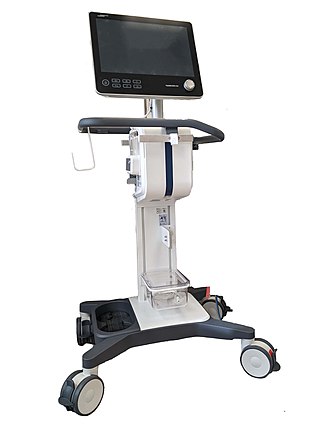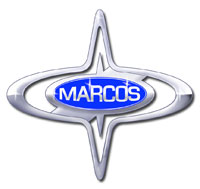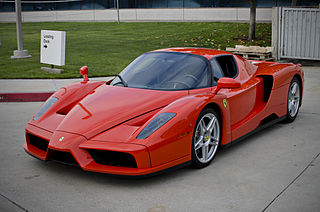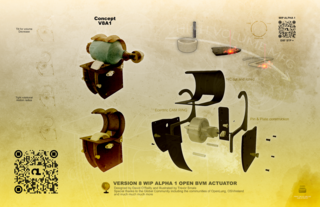
A flying car or roadable aircraft is a type of vehicle which can function both as a road vehicle and as an aircraft. As used here, this includes vehicles which drive as motorcycles when on the road. The term "flying car" is also sometimes used to include hovercars and/or VTOL personal air vehicles. Many prototypes have been built since the early 20th century, using a variety of flight technologies. Most have been designed to take off and land conventionally using a runway. Although VTOL projects are increasing, none has yet been built in more than a handful of numbers.

A ventilator is a type of breathing apparatus, a class of medical technology that provides mechanical ventilation by moving breathable air into and out of the lungs, to deliver breaths to a patient who is physically unable to breathe, or breathing insufficiently. Ventilators may be computerized microprocessor-controlled machines, but patients can also be ventilated with a simple, hand-operated bag valve mask. Ventilators are chiefly used in intensive-care medicine, home care, and emergency medicine and in anesthesiology.

Marcos Engineering was a British sports car manufacturer. The name derives from the surnames of founders Jem Marsh and Frank Costin.

The Ferrari Enzo, officially marketed as Enzo Ferrari, is a mid-engine sports car manufactured by Italian automobile manufacturer Ferrari and named after the company's founder, Enzo Ferrari. It was developed in 2002 using Formula One technology, such as a carbon-fibre body, Formula One-style automated-shift manual transmission, and carbon fibre-reinforced silicon carbide (C/SiC) ceramic composite disc brakes, as well as technologies not allowed in Formula One, such as active aerodynamics. The Enzo's F140 B V12 engine was also the first of a new generation for Ferrari. The Enzo generates substantial amounts of downforce through its front underbody flaps, small adjustable rear spoiler and rear diffuser, which work in conjunction to produce 343 kilograms (756 lb) of downforce at 200 km/h (124 mph) and 775 kilograms (1,709 lb) of downforce at 300 km/h (186 mph), before decreasing to 585 kilograms (1,290 lb) at top speed.

The Defence Research and Development Organisation (DRDO) is an agency under the Department of Defence Research and Development in Ministry of Defence of the Government of India, charged with the military's research and development, headquartered in Delhi, India. It was formed in 1958 by the merger of the Technical Development Establishment and the Directorate of Technical Development and Production of the Indian Ordnance Factories with the Defence Science Organisation under the administration of Jawaharlal Nehru. Subsequently, Defence Research & Development Service (DRDS) was constituted in 1979 as a service of Group 'A' Officers / Scientists directly under the administrative control of the Ministry of Defence.

The Bugatti EB 110 is a mid-engine sports car initially conceived by Ing. Paolo Stanzani in the mid 1980s and produced by Bugatti Automobili S.p.A. from 1991 until 1995, when the company was liquidated. The model restarted the brand's presence in the automobile industry after a hiatus of nearly 40 years.

The Jaguar XJ220 is a two-seat sports car produced by British luxury car manufacturer Jaguar from 1992 until 1994, in collaboration with the specialist automotive and race engineering company Tom Walkinshaw Racing. The XJ220 recorded a top speed of 217 mph (349 km/h) during testing by Jaguar at the Nardo test track in Italy. This made it the fastest production car from 1992 to 1993. According to Jaguar, an XJ220 prototype managed a Nürburgring lap time of 7:46.36 in 1991 which was faster than any production car lap time before it.
The Buckeye Bullet is a series of four experimental electric cars created by students from Ohio State University as a joint project with Venturi. The cars were designed to break the land speed record on the Bonneville Speedway, a salt flat just outside Wendover, Utah, United States. The team first achieved its goal in October 2004, at 271.737 mph (437.318 km/h) for the one mile world record, repeatedly increasing the record until setting a mile world record of 307.666 mph (495.140 km/h), in 2009, and a one kilometer world record of 341.264 mph (549.211 km/h), in 2016.
The Chevrolet Engineering Research Vehicle (CERV) is a series of Chevrolet experimental cars. Chevrolet Staff engineer, designer, and race car driver Zora Arkus-Duntov started development of the CERV I in 1959, and began work on the CERV II in 1963. Chevrolet chief engineer Don Runkle and Lotus' Tony Rudd discussed creating a new show car to demonstrate their engineering expertise in 1985; It would become the CERV III. Corvette chief engineer Dave Hill unveiled the CERV IV in 1993, a test vehicle for the 1997 C5 Corvette.
Jason Castriota is an automotive designer.

The Ferrari P4/5 is a one-off sports car made by Italian sports car manufacturer Ferrari but redesigned by Pininfarina for film director James Glickenhaus, son of stock exchange magnate Seth Glickenhaus.

PT Pindad (Persero) (formerly abbreviated from Perindustrian Angkatan Darat, lit. 'Indonesian Army Industries'), is an Indonesian state-owned enterprise specialising in military and commercial products. Pindad provides the armaments and munitions (alat utama sistem persenjataan, Alutsista) for the Indonesian National Armed Forces and other uniformed agencies mainly to support the defense and security capabilities of the Republic of Indonesia.
Bloodhound LSR, formerly Bloodhound SSC, is a British land vehicle designed to travel at supersonic speeds with the intention of setting a new world land speed record. The arrow-shaped car, under development since 2008, is powered by a jet engine and will be fitted with an additional rocket engine. The initial goal is to exceed the current speed record of 763 mph (1,228 km/h), with the vehicle believed to be able to achieve up to 1,000 miles per hour (1,609 km/h).

The L0 Series is a high-speed maglev train which the Central Japan Railway Company has been developing and testing. JR Central plans to use the L0 series on the Chūō Shinkansen railway line between Tokyo and Osaka, which is under construction.

The University of Texas Solar Vehicles Team (UTSVT) is a student-driven effort to design, build, test, and race solar vehicles for the purpose of reinforcing skills learned in the classroom, raising awareness of solar power, and bringing solar power closer to practicality. To accomplish this task, a multidisciplinary group of students from various disciplines in the Cockrell School of Engineering, and from other schools across the University of Texas, such as the College of Liberal Arts and the College of Natural Sciences come together to design and construct the most efficient vehicle as possible.
The Korres P4 is a Greek sports car designed by Korres Engineering. It is a true all-terrain vehicle utilizing a suspension design based on the principle of wheel interdependence.
Kiira Motors Corporation or KMC is a State Enterprise in Uganda established to champion the Development of the Domestic Automotive Value Chain for job and wealth creation and commercialize the Kiira Electric Vehicle Project. The Equity Partners are the Government of the Republic of Uganda represented by the Ministry of Science, Technology and Innovation, Office of the President holding 96% of the initial stock and Makerere University holding 4%.
Spark Racing Technology (SRT) is a motorsport manufacturer specialized in the development and engineering of high-performance electric vehicles and modules. The company was founded by Frédéric Vasseur to become the sole chassis supplier for the FIA Formula E Championship but is now involved in other projects as well.

The Alpina B3 (E90) and Alpina D3 (E90) are a series of high performance compact executive cars manufactured by German automobile manufacturer Alpina from 2007 to 2013. Based on the BMW 3 Series (E90), the B3 and D3 were available in coupé, saloon, convertible and station wagon body styles. The B3 was officially unveiled at the 2007 Geneva Motor Show.

An open source ventilator is a disaster-situation ventilator made using a freely licensed (open-source) design, and ideally, freely available components and parts. Designs, components, and parts may be anywhere from completely reverse-engineered or completely new creations, components may be adaptations of various inexpensive existing products, and special hard-to-find and/or expensive parts may be 3D-printed instead of purchased. As of early 2020, the levels of documentation and testing of open source ventilators was well below scientific and medical-grade standards.













